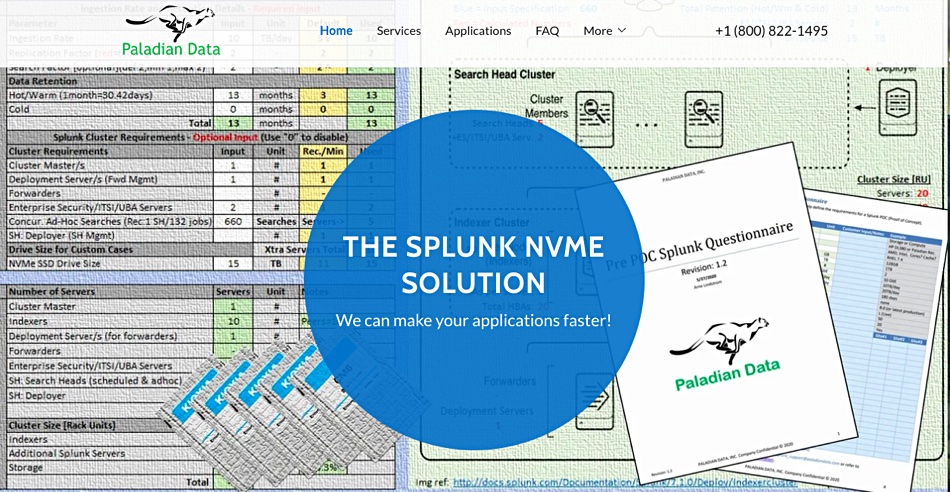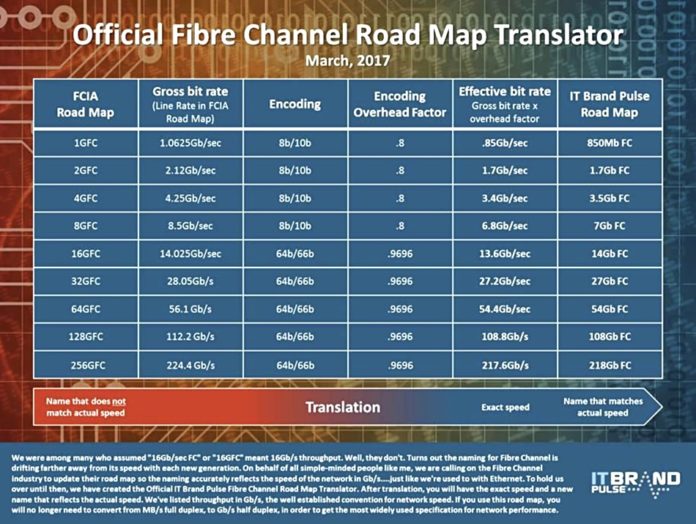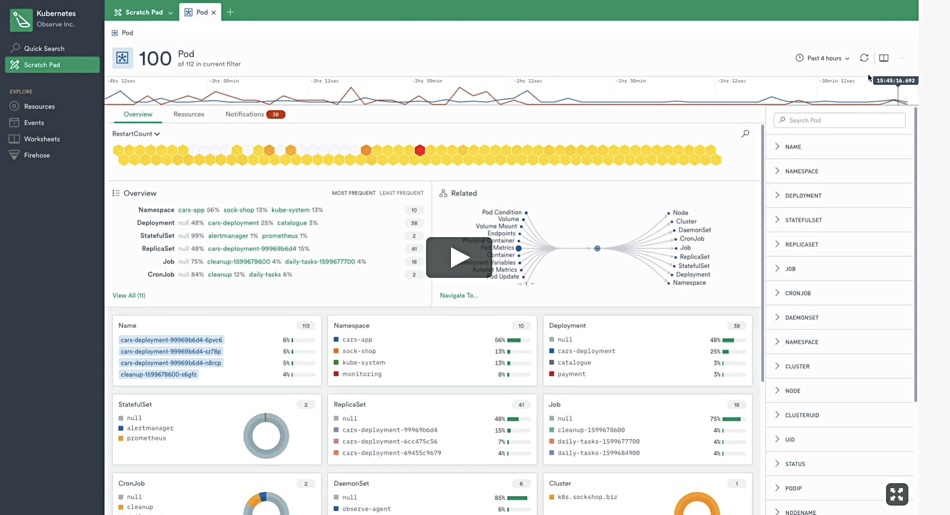This week has been busy with storage news, like last week and the one before that. Ransomware protection has become a top-of-mind CIO concern and – among others – Backblaze and Veeam have teamed up to provide it.
Fibre Channel speeds are a concern to IT Brand Pulse; it has said indicated speeds, like car speedometers, overstate the real speed. And media workflow supplier OpenDrives has bulked up its NAS product by adding clustering while start-up Observe introduces great log file diagnosis and analytics capabilities.
Backblaze and ransomware
Backblaze B2 Cloud Storage now supports data immutability for Veeam backups and is available. It uses virtual air-gapping.
A Blackblaze blog by Natasha Rabinov says: “With object lock functionality, there is no longer a need for tapes or a Veeam virtual tape library. You can now create virtual air-gapped backups directly in the capacity tier of a Scale-out Backup Repository (SOBR). In doing so, data is Write Once, Read Many (WORM) protected [and] data can be restored on demand.”
Data immutability begins by creating a bucket that has object lock enabled. Then within your SOBR, you can simply check a box to make recent backups immutable and specify a period of time.

Selecting object lock will ensure that no one can:
- Manually remove backups from the Capacity Tier.
- Remove data using an alternate retention policy.
- Remove data using lifecycle rules.
- Remove data via tech support.
- Remove by the “Remove deleted items data after” option in Veeam.
Once the lock period expires, data can be modified or deleted as needed.
B2 Cloud Storage is the only public cloud storage alternative to Amazon S3 to earn Veeam’s qualifications for compatibility and immutability.
Fibre Channel 32 and 64Gbit/s actually run slower
IT Brand Pulse’s Frank Berry has said that FCIA Fibre Channel generations don’t match up to their nominal speed billing. He tells us: “For the last few years I have been lobbying the FCIA to fix their naming. With each generation it gets more out of wack.” Meaning it’s slower than the name suggests.
He wrote this in a 2017 LinkedIn article:“The network technology named ’10GbE’ means throughput is 10Gb/s, and if you’re like most people, you would naturally believe the network called ’32GFC’, means throughput is 32Gb/s. The reality is the name matches the speed for Ethernet, but surprisingly not for Fibre Channel. The speed of the network is significantly less than the names for each generation of Fibre Channel.”
Berry said the FCIA uses baud rate as its reference point for naming: “What should be used to identify each new generation of Fibre Channel, is a well established convention: half-duplex throughput in Gbit/s. You can arrive at that number by multiplying the baud rate by a factor for encoding overhead.”
He’s produced a FC speed translation table:

Observe starts up
Ex-Dell Technologies CMO Jeremy Burton has co-founded Observe with VC Mike Speiser. Burton is the CEO and Speiser on the board as an investor.
Burton told B&F: “The idea with Observe was to take all of what folks like Splunk do (logs), all of what DataDog does (metrics) and all of what New Relic does (traces) and do it in a single product…. and store all the data in a single – Snowflake – database. The thought is that bringing data together gives users more visibility into what’s going on and helps them find problems faster. And if we can do that – not unlike Pure attacking Storage or Snowflake attacking databases – the market is massive.”
He said that, with K8s and AWS, we transform raw log events and metrics into things SREs (site reliability engineers) recognise such as containers, pods, EC2 instances and S3 buckets, and understand all the relationships between them.
“In distributed systems like Kubernetes, logs are often riddled with GUIDs that refer to other objects. Under the hood Observe is powered by Snowflake. Because it’s a relational database, we can easily figure out relationships in your K8s infrastructure and tell you what they mean. Our Teleport feature navigates all of the relationships across the data and returns us logs for the subset of jobs we want to look at.”
An Observe blog has a video about using its facilities to diagnose K8s problems.
OpenDrives
Video post production NAS system supplier OpenDrives has announced v2.1 of its Atlas NAS software. It includes:
- Storage Clustering allows individual scale-up devices, or nodes, to be aggregated together forming a cluster with balanced workloads among cluster nodes.
- Containerisation with OpenDrives claiming it’s the first to approach containerisation from the storage side and achieve huge performance gains by intelligently and efficiently delivering data to the container.
- Conditional Automation is a complementary feature to containerisation enabling triggering actions, such as time-based or file-based actions, to create automated tasks (snapshiots, bandwidth throttling, containerised apps) that fire up and operate independently of other tasks.
- Centralized Management and Visibility through a single pane of glass with easy-to-consume APIs enabling more extensive telemetry information for analytics, and better configuration settings to tune nodes and storage clusters.
- Cloud Storage Support for AWS S3. Altas 2.1 users can send and receive both on-premise and cloud data via the S3 protocol, and share S3 remote targets through Service Message Blocks (SMB) locally.
- High Availability – users can choose from a dual C-Module or fully clustered and distributed deployments, all supported and managed by Atlas for storage service continuity.
Shorts
NVMe-oF-clsss storage array startup Apeiron appears to have morphed into Paladian Data. Despite hiring Chuck Smith, an ex-HPE exec, as its CEO, Apeiron did not grow enough to survive. Smith has gone. Lee Harrison, Apeiron’s CTO and co-founder, has set up Paladian with the same original focus as Apeiron: big data analytics via Splunk.

Olga Tokarczuk, Nobel Prize Literature laureate from Poland, has stored her life’s work of 14 books on piqlFilm in the safety and security of the Arctic World Archive (AWA), for perpetuity. The AWA in Longyearbyen, Svalbard, is a joint venture between the Norwegian state coal mining company Store Norske Spitsbergen Kulkompani (SNSK) and Piql, a Norwegian archive technology business. SNSK has the hole in the ground and PiqI makes the film reel cartridges that go into it.
Data protector Assigra has signed up Nimbus Clouds Services to deploy ransomware-enabled cloud backup services throughout Malaysia, Sri Lanka and Indonesia.
CodeLathe, which supplies the FileCloud enterprise file service platform FileCloud, has achieved Amazon Web Services (AWS) Digital Workplace Competency status.
Dalet, a media workflow system supplier, has joined Spectra Logic‘s certification program to deliver an integrated system that combines Dalet Galaxy five with Spectra’s BlackPearl Object Storage platform,
DataStax unveiled a DataStax Fast 100 program to match Apache Cassandra experts to enterprise projects. Partners on-board, with more to come, include: Deloitte, Expero Inc, and Anant Corporation. The program provides enablement for partners with consultants certified and ready to deliver on Cassandra engagements within 30-days.
DDN announced its A31 all-flash and hybrid storage system alongside NVIDIA’s DGXTM POD are being used by CMKL University, Thailand , the premier AI University in Southeast Asia, to support research projects spanning from machine learning, connected and automated transportation, food and agricultural analytics to precision health and more.
Cloud-native Kubernetes storage system supplier Diamanti says its D20 RH release supports Red Hat OpenShift 4.5.
Deduping backup target array supplier Exagrid, competing against Dell EMC PowerProtect, and others, hit its plan for the quarter ending September 30, 2020 and added over 100 new customers in the quarter. They included a record 27 new customers with initial six-figure purchases and one existing customer with a seven-figure purchase.
CEO Bill Andrews said: “We are replacing low-cost primary storage disk from Dell, HPE, and NTAP behind Commvault and Veeam, as ExaGrid is far less expensive for longer-term retention. We are also consistently replacing Dell EMC Data Domain and HPE StoreOnce inline scale-up deduplication appliances.”
HPCnow!, a provider of supercomputing and high performance computing (HPC) services for scientific and research organisations, is using Excelero’s NVMesh software. It has has performed a pilot at ALBA, a synchrotron light facility near Barcelona, using elastic NVMe-based data storage to support the acquisition and processing of the massive volumes of scientific data generated by its high performance beamlines, which use soft and hard X-rays’ intense light source beams to help to characterise materials, their properties and behaviour.
Chinese server systems supplier Inspur has built a Cloud SmartNIC using Nvidia’s BlueField-2 DPU. With a PCIe 4.0 switch the system can deliver up to 200Gbit/s bandwidth. It offloads functions like software-defined networking (SDN), software-defined storage (SDS), and encryption and security processing from the host CPU.
Inspur says that means the Cloud SmartNIC offloads host server CPU functions like traffic management, storage virtualisation, and security isolation, significantly freeing CPU computing resources. It envisages servers with the Cloud Smart NIC being used for AI, big data analytics, cloud, virtualisation, micro-segmentation, and next-generation firewalls.
Inspur has announced an SPC-1 benchmark result for its AS5300 G5 array, which places it at number 10 in the SPC-IOPS list. Its AS5600 G2 array is at number 3 with a 7,520,358 IOPS score. And its AS5500 G5 is ninth with 3,300,292 IOPS.

JetStream Software has a business continuity and disaster recovery offering for Azure. By replicating data continuously and directly into Azure Blob Storage, JetStream DR enables continuous data protection (for a near-zero RPO) at a lower cost than other solutions. Recovery resources can be provisioned in AVS as needed, with the protected VMs and their data rehydrated from Azure Blob Storage.
Model9 told us about a September Gartner Cloud Storage Management Is Transforming Mainframe Data report. Its abstract says: “Advances in cloud storage and data protection management are transforming mainframe tape environments, enabling organizations to reduce storage costs and unlock new business value. I&O leaders must modernise tape systems by migrating mainframe backup data to subscription-based cloud solutions.” CTO Gil Peleg says Model9 is gaining momentum in the market and recruiting top talent (including C-level from Kaminario and Infinidat).
Netlist announced production shipments of its high performance N1952 and low power N1552 product line of NVMe SSDs. Both use 96-layer 3D NAND and firmware that provides superior performance, data integrity and security using standards-based T10 Protection Information (PI) and encryption key management features. They have transfer speeds up to 6 GB/sec and up to 1 million random read IOPs (N1952).
Nutanix has anextended multi-level Nutanix Certification Program with certifications across four skill levels and six new technology tracks. The tracks include Digital HCI Services (Multicloud Infrastructure), Sata Centre Services (Data Storage Services, Security & Governance, Business Continuity), DevOps Services (Multicloud Automation, Database Automation) and Desktop Services (End User Computing).
NVME flash array supplier Pavilion Data announced a Federal Agency has expanded its deployment of the Pavilion Hyperparallel Flash Array (HFA) to accelerate workflows in their IBM Spectrum Scale environment. The agency has spent an 8-figure sum on Pavilion Data kit.
Researchers at MINES ParisTech, a French engineering school, have implemented Panasas ActiveStor high-performance computing (HPC) storage to support research efforts at the university’s Materials Research Centre.
Pure Storage’s FlashRecover, the data protection and management system comprising a FlashBlade array with a white box server that runs Cohesity’s Data Platform software, is now generally available.
Kubernetes management platform supplier Rancher Labs announced Rancher 2.5 software with a new installation experience, GitOps at scale for edge clusters, full lifecycle management of EKS clusters and a new security-hardened, certified Kubernetes distribution for government customers.

Scality may have a branding problem with its SOFS (Scale Out File System). We’re told that, since 2008 , SOFS stands for Sven Oehme File System. Who is Sven Oehm? He is DDN’s Chief Research Officer.
Startup Stellus may have closed down. It was backed by Samsung and developing a key:value store-based flash array. Chief Revenue Officer Ken Grohe left in May this year, just 3 months after the first Stellus product was launched. CEO Jeff Treuhaft new appears to have quit, according to his LinkedIn entry. We have been unable to obtain any comment from Samsung.
Research outfit Trendfocus has suggested hard disk drive manufacturers may have to move from 9-platter drives to 10-platter ones to achieve 24TB and higher-capacity drives.
Hosting and cloud services provider Leaseweb Global announced the integration of Veeam SW with its Leaseweb Cloud Services.
Replicator WANdisco announced Public Preview availability for its LiveData Platform for Microsoft Azure. It says open Public Preview is a critical late stage phase of roll-out across Microsoft Azure ahead of a combined Microsoft and WANdisco go-to-market launch of the capability.
Cloud storage supplier Wasabi signed up reseller Micropac Technologies to deliver Wasabi’s cloud storage service to customers in the US health care and IoT markets as well as federal, state, local and education (SLED) government agencies.
Wasabi and Flexential are partnering to launch Flexential Archive Storage which is designed to enable businesses to store long-term unstructured data from any source in an affordable, fast and straightforward way.









